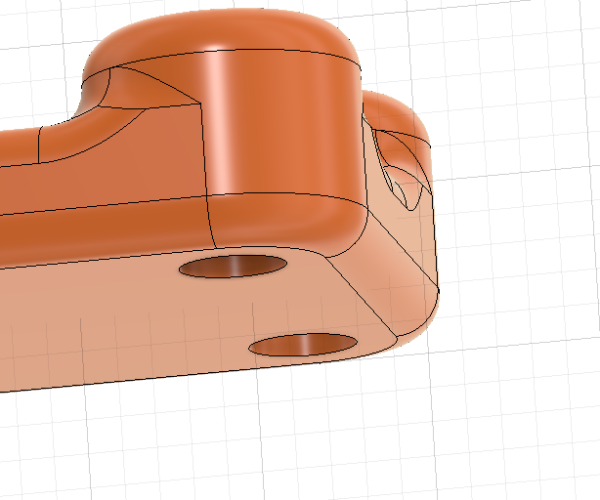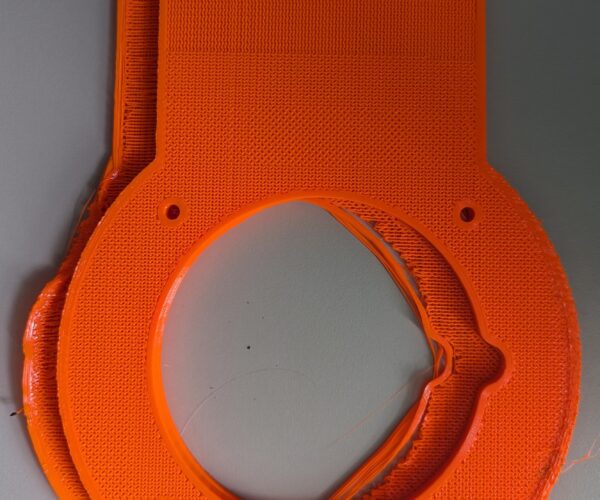Massive midlayer shift - the result of a nozzle collision?
Hi I'm pretty new to 3d printing, i've been trying to get some PETG prints working and i thought i'd got the my settings dialled in for petg (i'm trying to print something strong and on test prints i was getting layer separation and gaps so i increased extrusion a bit to 1.05, increased the temperatures by 10 degrees and turned off the tool head fan and things the the calibration prints looked ok). but then I got this massive layer shift in the middle of a print. The only thing i could think of was I might have got some blobs that the nozzle hit it which yanked the top layer and several connecting layers off the side before the print continued as normal. Though i don't understand why the nozzle would be travelling outside the perimeter of the object so i wanted to check with more experienced people whether my theory holds water or whether something else is likely going on.
I'm using an MK3S+ (built from a kit). Prusament orange PETG.
I'm using the default 0.2mm quality settings with the following modifications: 50% gyroid infil, 5 perimeters, top and bottom. Only retract when crossing perimeters. Max print speed is 80 mm/s and max volumetric speed is 5.5 mm^3/s. Printing fanless with 85C bed and 250C tool for the first layer and 90C bed and 260C tool for subsequent layers.
Many thanks for your consideration.
Best Answer by Diem:
@fuchsr and @jimb are right.
My suggestion:
Reduce the fillet to a 1mm 45° chamfer just to soften the edge. Try 6 or 7 perimeters and 20% gyroid or cubic infill. Add a brim, zero elephant's foot compensation and thoroughly clean the build sheet - dishwashing detergent and HOT water are fine with the textured sheet but you MUST get it dry as fast as possible to prevent rusting - if you are not printing straight away hairdryers are good for drying.
Cheerio,
RE: Massive midlayer shift - the result of a nozzle collision?
Oh i should add before printing i dried the petg for 6 hours at 60 degrees in a dehydrator and i'm printing in a (fabric) enlosure with a vent open, the ambient temperature (as measured by a pi with a sensor in the enclosure) didn't get above 28 degrees C.
This might be an adhesion issue. Your photo shows signs of warping, allowing the part to lift from the bed thereby causing the crash you suspect.
Cheerio,
RE: Massive midlayer shift - the result of a nozzle collision?
50% infill is way too much but that doesn't give you layer shifts. Usual causes are loose belts, slipping grub screws on the motor shafts, collisions. Common causes for collisions are--as Diem mentioned— nozzle hitting an area that has warped, or nozzle hitting infill (which I wouldn't expect with gyroid). Of course if you have a dirty or leaking hotend you may also have filament drip down on the print and create an obstacle.
Formerly known on this forum as @fuchsr -- https://foxrun3d.com/
RE:
Hi guys thanks so much for the advice. I think i've narrowed it down to one of your suggestions - that i'm getting warping/lifting leading to a collision. This shows a restarted print where i can see that the bottom edge has already lifted and started to hit the nozzle.

So I guess my next question is how should try to resolve this - i'm currently printing in an enclosure but with a vent open so the temperature is 25-30 degrees C. Obviously i could just try closing the vent though because it's a fabric enclosure i don't think the ambient temperature will rise that much. I could also try increasing the bed temperature? Or try a raft? Alternatively should i modify the design - it printed find in PLA but i know petg is prone to more warping. I did put a fillet on the edge: 
But maybe it's not enough and i need a deeper one?
Also the 50% infil being too much. I kind of want this part to be strong under both compression and tension. The load will be dynamic or atleast the direction of the load will be dynamic so i went with 5 perimeters and 50% gyroid infil, because i saw somewhere or other (CNC kitchen maybe?) that past about 50% increasing infil doesn't make much difference. Because the load is through the body (via through bolts in the four holes in the upper ring) i thought relying only on the perimeters wasn't too wise is my thinking wrong here?
Any suggestions gratefully recieved.
Thanks again.
RE: Massive midlayer shift - the result of a nozzle collision?
I did put a fillet on the edge:
Fillets on bottom edges can be a bit of a problem. Chamfers work better in the bottom.
Also the 50% infil being too much. I kind of want this part to be strong under both compression and tension. The load will be dynamic or atleast the direction of the load will be dynamic so i went with 5 perimeters and 50% gyroid infil, because i saw somewhere or other (CNC kitchen maybe?) that past about 50% increasing infil doesn't make much difference. Because the load is through the body (via through bolts in the four holes in the upper ring) i thought relying only on the perimeters wasn't too wise is my thinking wrong here?
Most of the strength will come from the perimeters and top/bottom layers. If it were me, I would set the infill to something like 20%. Once you get it to print successfully, try to break it. If it breaks under expected load, then make adjustments and see if that gets better or worse. Don't make too many adjustments at once or you won't be able to tell what setting had what affect..
@fuchsr and @jimb are right.
My suggestion:
Reduce the fillet to a 1mm 45° chamfer just to soften the edge. Try 6 or 7 perimeters and 20% gyroid or cubic infill. Add a brim, zero elephant's foot compensation and thoroughly clean the build sheet - dishwashing detergent and HOT water are fine with the textured sheet but you MUST get it dry as fast as possible to prevent rusting - if you are not printing straight away hairdryers are good for drying.
Cheerio,

